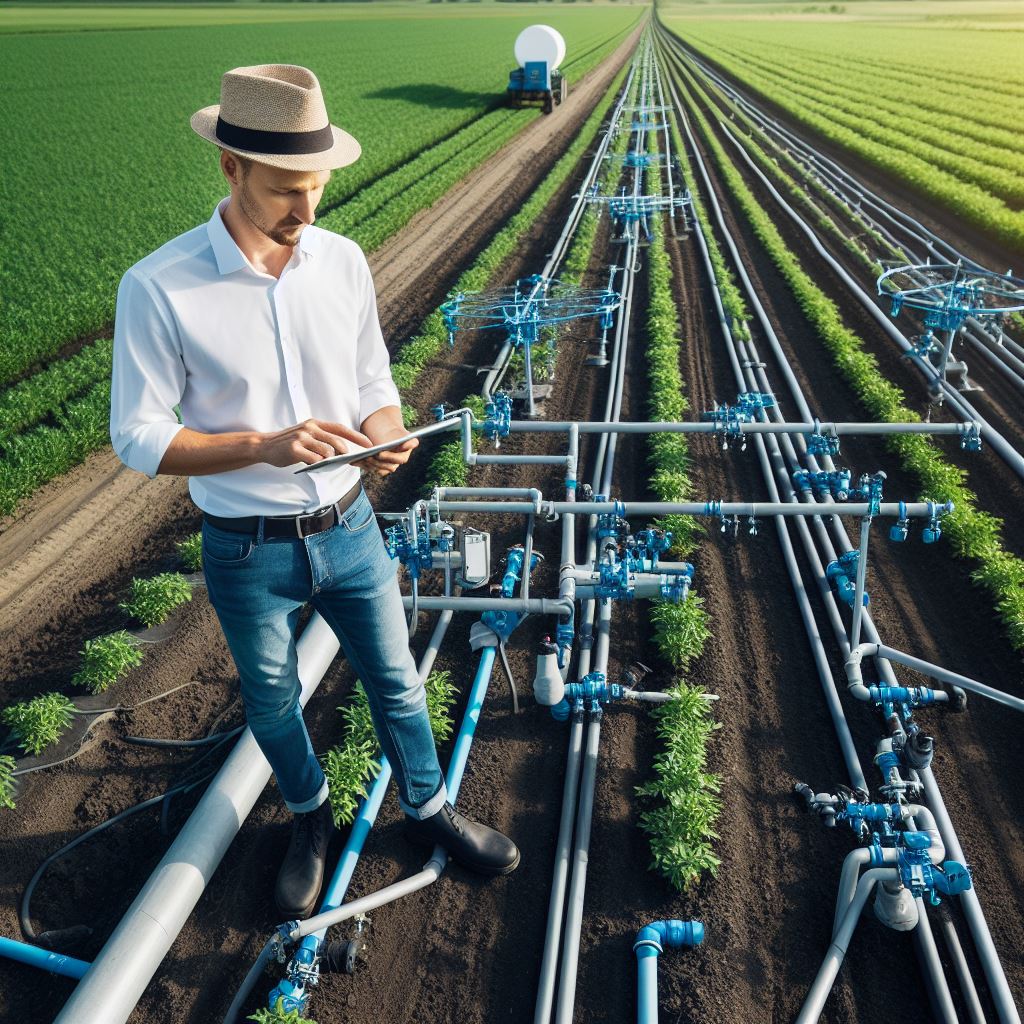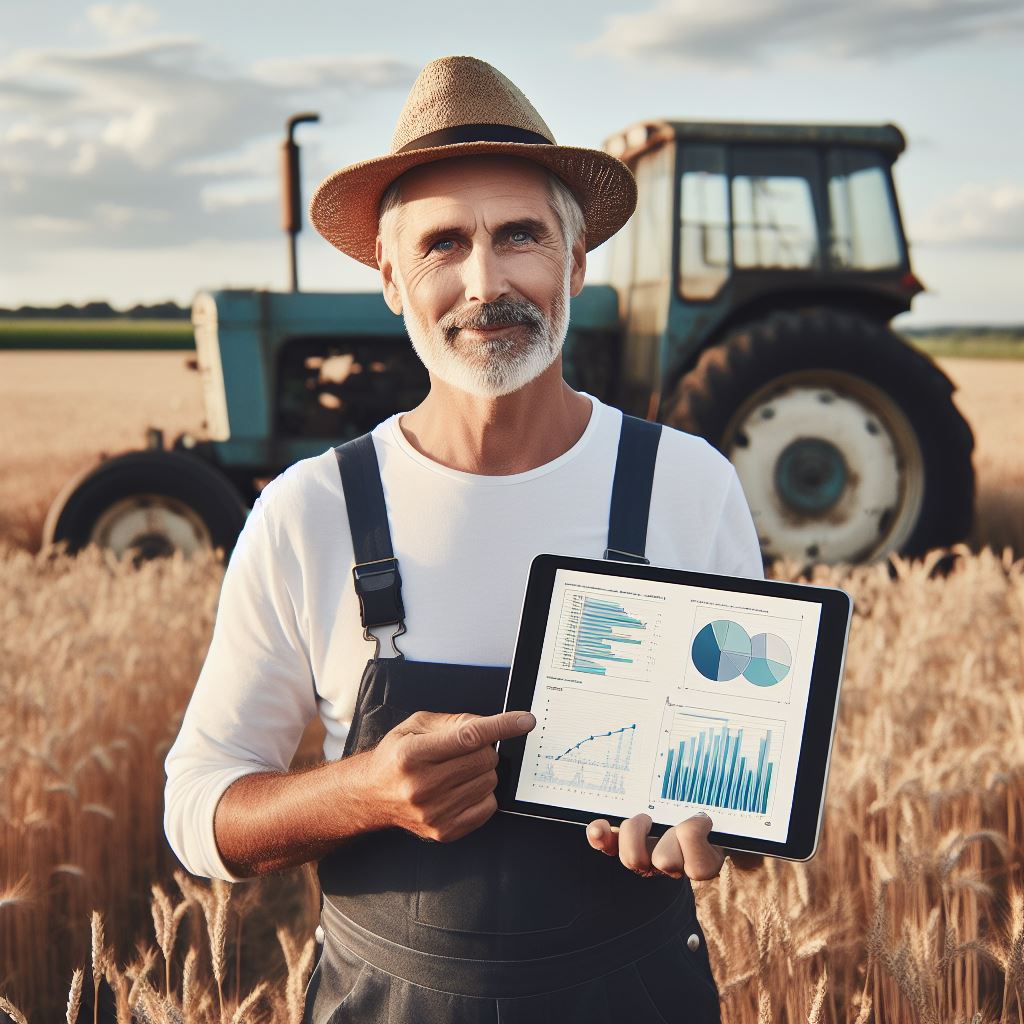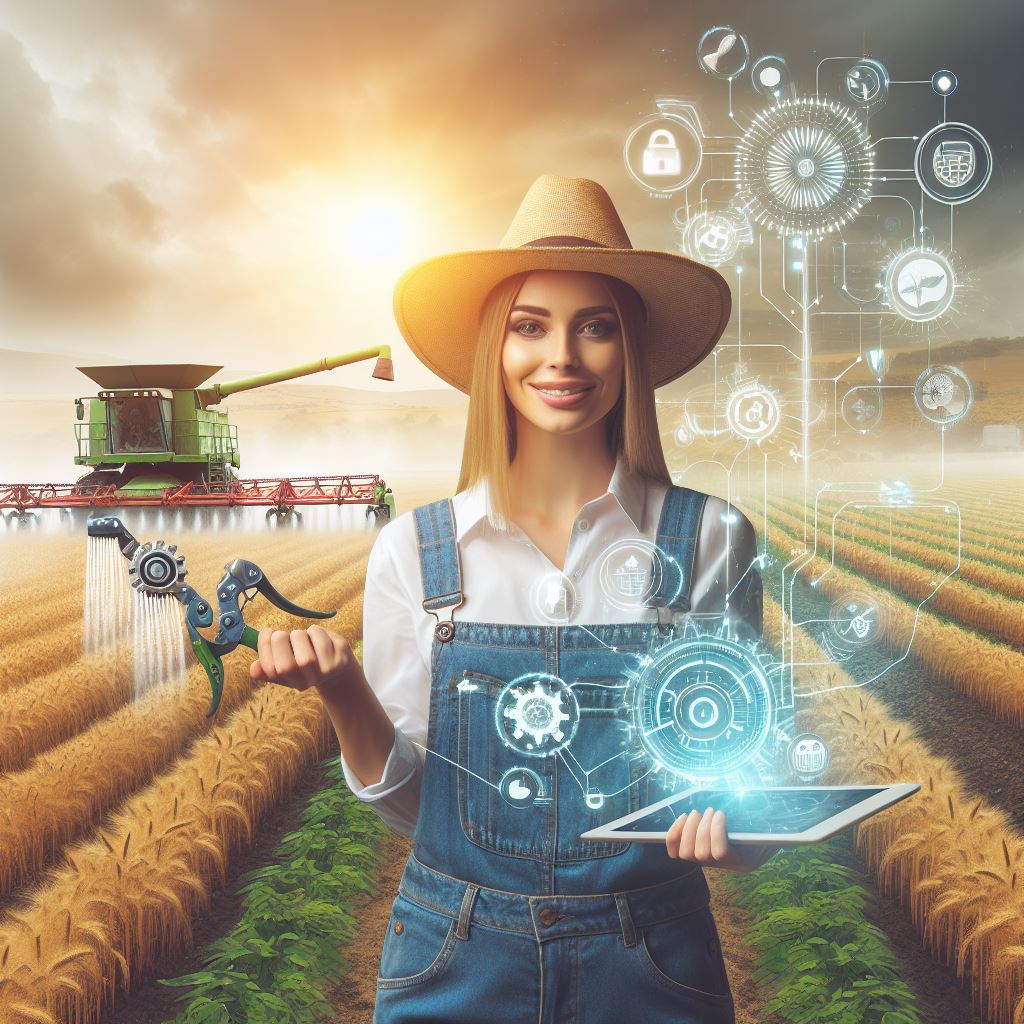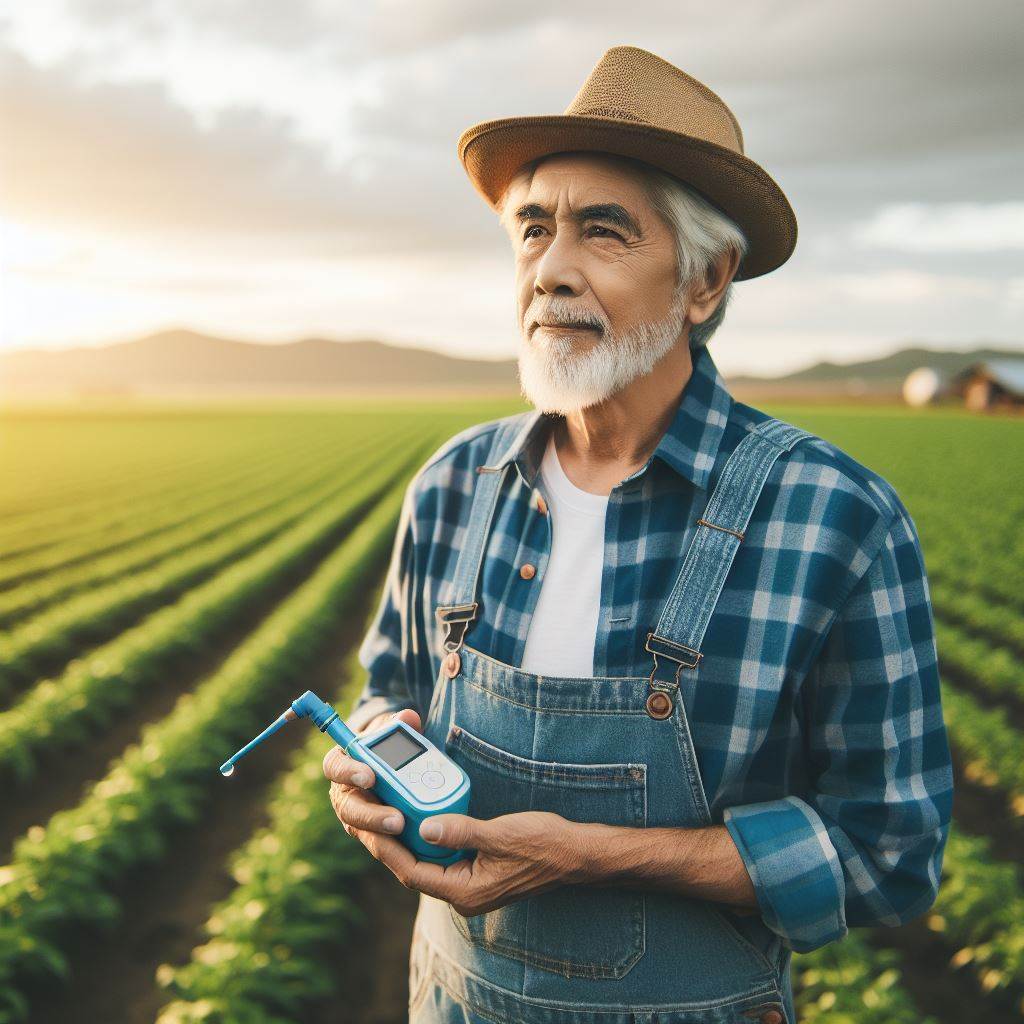Introduction
Automated irrigation refers to the use of technology to control the watering of plants and crops.
It is an innovative system that allows for efficient water distribution.
Automated irrigation systems involve the use of sensors, controllers, and valves to deliver water to plants.
These systems eliminate the need for manual labor and reduce water wastage.
Water conservation in farming is crucial as it helps to preserve this precious resource while increasing productivity.
Using automated irrigation systems ensures that water is used optimally, minimizing waste and reducing the overall water consumption.
By implementing automated irrigation, farmers can accurately monitor soil moisture levels and provide plants with the necessary amount of water.
This prevents overwatering, which can lead to leaching and the loss of valuable nutrients.
In addition to saving water, automated irrigation also saves time for farmers.
It eliminates the need for manual watering, allowing farmers to focus on other important aspects of crop management.
Furthermore, automated irrigation systems can be programmed to water at specific times, ensuring a consistent water supply for plants.
This helps to promote plant health and growth.
Overall, automated irrigation offers a range of benefits, including water conservation, time savings, and improved crop yield.
It is a valuable tool for farmers seeking to maximize efficiency while minimizing their environmental impact.
Benefits of automated irrigation
Automated irrigation systems offer numerous benefits for farmers and gardeners alike.
Transform Your Agribusiness
Unlock your farm's potential with expert advice tailored to your needs. Get actionable steps that drive real results.
Get StartedBy efficiently utilizing water, these systems can reduce waste and conserve a precious resource.
Additionally, automated irrigation saves valuable time and effort by eliminating the need for manual watering.
Furthermore, this technology promotes enhanced crop health and higher yields.
Let’s explore each of these benefits in more detail:
Efficient water usage
- Precision watering: Automated irrigation systems are equipped with sensors that detect soil moisture levels. This enables precise watering tailored to the specific needs of plants, preventing over or under-watering.
- Water conservation: By delivering water directly to the root zone of plants, wastage due to evaporation or runoff is minimized. This ensures that every drop of water is utilized effectively, reducing overall water consumption.
Time-saving capabilities
- Schedule flexibility: With automated irrigation, users can set specific watering schedules based on individual plant requirements. This eliminates the need for manual watering and allows gardeners to focus on other important tasks.
- Remote control: Some automated systems can be controlled remotely, allowing users to adjust watering schedules or turn the system on or off from anywhere. This eliminates the need to physically be present, especially during vacations or busy periods.
Enhanced crop health and yields
- Consistent watering:Automated irrigation maintains consistent water supply, vital for plant health, promoting growth, reducing stress, and preventing water-related diseases.
- Nutrient absorption: Automated systems evenly distribute water, facilitating efficient nutrient absorption by plants, thereby enhancing health, yield, and crop quality.
In addition to these primary benefits, automated irrigation systems also offer several secondary advantages:
- Weed prevention: Automated irrigation focuses solely on plant areas, decreasing moisture for weeds, suppressing their growth, and reducing manual weeding needs.
- Reduced labor: Automated watering eliminates manual tasks like dragging hoses, saving time and effort, and making gardening less labor-intensive.
- Environmental sustainability: By conserving water and reducing the need for pesticides, automated irrigation contributes to a more sustainable agricultural and gardening practice.
- Cost savings:Although the upfront cost of an automated irrigation system may appear high, long-term savings from reduced water consumption and labor are significant.
In essence, automated irrigation systems provide numerous benefits, including efficient water usage, time-saving capabilities, and enhanced crop health and yields.
These systems are not only practical but also environmentally friendly, contributing to sustainability efforts.
With the wide range of advantages they offer, automated irrigation systems are an excellent choice for any farmer or gardener looking to optimize their water usage and save time and effort in the process.
Read: Automated Tractors: The Future is Here
Components of an automated irrigation system
Irrigation is essential for maintaining healthy plants and promoting successful crop growth.
However, traditional irrigation methods can be time-consuming and wasteful, leading to the need for a more efficient solution.
This is where automated irrigation systems come into play.
By utilizing sensors, monitoring devices, controllers, timers, valves, and water distribution mechanisms, these systems revolutionize the way water is managed and distributed to plants.
Sensors and monitoring devices
These components are the backbone of an automated irrigation system.
They measure various environmental factors such as soil moisture levels, temperature, and humidity.
By constantly monitoring these parameters, sensors can provide accurate data that helps determine the precise water requirements of plants.
Controllers and timers
Controllers act as the brain of the irrigation system, receiving input from the sensors and making informed decisions based on the collected data.
They can be programmed to activate or deactivate irrigation cycles at specific times or when certain conditions are met.
Timers work hand in hand with controllers, allowing for precise scheduling and duration of irrigation cycles.
Valves and water distribution mechanisms
- Valves play a crucial role in an automated irrigation system by controlling the flow of water.
- They can be manually or electronically operated and are positioned strategically throughout the irrigation network.
- Water distribution mechanisms, such as sprinklers or drip emitters, are attached to the valves and deliver water directly to the plants in a controlled manner.
In summary, automated irrigation systems have revolutionized the way water is managed and distributed to plants.
By utilizing sensors, monitoring devices, controllers, timers, valves, and water distribution mechanisms, these systems deliver water precisely and efficiently.
This promotes water conservation, saves time and labor, improves crop yield, and offers increased flexibility.
As the world faces water scarcity and the need for sustainable farming practices, automated irrigation systems prove to be a vital tool in conserving water resources while maximizing agricultural productivity.
Read: Agri-Tech Startups: Bridging Tech and Farming
Showcase Your Farming Business
Publish your professional farming services profile on our blog for a one-time fee of $200 and reach a dedicated audience of farmers and agribusiness owners.
Publish Your ProfileHow automated irrigation works
Irrigation is an essential practice for maintaining healthy plants and crops. However, traditional methods can be inefficient, time-consuming, and wasteful.
That’s where automated irrigation comes in to revolutionize the way we water our plants.
By utilizing sensor-based irrigation scheduling, real-time data collection, and automatic adjustment of watering patterns, automated irrigation systems are able to save water and time.
How does automated irrigation work? Let’s explore the key components that make this innovative technology possible.
Sensor-based irrigation scheduling
Automated irrigation systems are equipped with sensors that monitor various environmental factors such as soil moisture levels, temperature, and humidity.
These sensors provide crucial data that helps determine when and how much water is needed for optimal plant growth.
By using this data, the system can create a customized watering schedule based on the specific needs of each plant or crop.
Real-time data collection and analysis
The sensor data collected by the automated irrigation system is continuously transmitted and analyzed in real-time.
This allows for immediate adjustments to be made based on changing environmental conditions.
For example, if the system detects a sudden increase in temperature, it can automatically increase the watering frequency to prevent plants from drying out.
Automatic adjustment of watering patterns:
- One of the major advantages of automated irrigation is its ability to adapt to changing circumstances.
- The system can automatically adjust watering patterns based on real-time data and predefined settings.
- For instance, during periods of heavy rainfall, the system can reduce or even pause watering to avoid overwatering.
By combining these three key components, automated irrigation systems offer numerous benefits:
- Water conservation: Traditional irrigation methods waste water through overwatering or inefficient scheduling, whereas automated irrigation delivers precise water amounts, minimizing waste.
- Time-saving: Automated irrigation relieves farmers and gardeners from manual watering and soil moisture monitoring, handling all watering tasks efficiently.
- Increased efficiency: Automated irrigation systems optimize watering patterns using real-time data, minimizing under or overwatering risks, thus improving plant health and crop yields.
- Remote control and monitoring: Users can remotely access and control many automated irrigation systems through mobile apps or web interfaces, enabling monitoring, alerts, and adjustments.
In a nutshell, automated irrigation is a game-changer in the world of agriculture and gardening.
By employing sensor-based irrigation scheduling, real-time data collection, and automatic adjustment of watering patterns, these systems offer efficient, water-saving, and time-saving solutions.
Whether you’re a farmer or a home gardener, investing in automated irrigation can not only benefit your plants but also contribute to a more sustainable and environmentally friendly future.
Read: Agri-Drones: Livestock Monitoring Tech
Case studies on successful implementation
Automated irrigation systems have revolutionized farming by saving water and time.
Here are some case studies and success stories showcasing the effectiveness of this technology:
- Farm A: situated in California, deployed an automated irrigation system, efficiently watering fields using moisture sensors and weather data. This resulted in a 30% reduction in water usage and a 20% increase in crop yield.
- Farm B: In a dry Australian region, Farm B faced water scarcity until adopting automated irrigation, which adjusted schedules based on soil moisture. This led to a 40% water reduction and healthier crops.
- Farm C: located in the US heartland, used automated irrigation for its vast acreage, achieving precise control and uniform water distribution. This resulted in a remarkable 25% crop quality increase and 35% less water wastage.
Examples of farms using automated irrigation
These case studies demonstrate the potential of automated irrigation systems in maximizing water efficiency and crop productivity.
Let’s explore some examples of farms that have successfully implemented this technology:
- The Green Acres Farm: In Oregon, a family-owned farm installed a state-of-the-art automated irrigation system, optimizing schedules with sensors and forecasts. This saved water and improved crop quality, showcasing automation’s agricultural benefits.
- The Golden Harvest Farm: in arid Nevada, battled water scarcity and manual labor with traditional irrigation until adopting automation. This cut water usage and labor costs, with remote monitoring for time and resource savings.
- The Sunshine Fields Farm: A large-scale vegetable farm in Florida aimed to cut water wastage and boost productivity. Implementing automated irrigation enabled precise watering, adjusting based on weather for significant water savings and higher yields.
Testimonials and success stories
Success stories and testimonials from farmers using automated irrigation further highlight the advantages of this technology:
- John Smith, a farmer from Texas, states, “Automated irrigation has transformed my farming practices. I no longer worry about overwatering or under watering my crops. The system saves me time and money, while conserving water resources.”
- Mary Johnson, an organic farmer in California, shares, “I saw a remarkable improvement in my yield after implementing automated irrigation. The system intelligently adjusts water supply, ensuring my crops receive just the right amount. It’s a game-changer!”
- Michael Thompson, a farmer in Australia, exclaims, “Automated irrigation has been a revelation for my farm. It has helped me combat water scarcity, increase crop production, and reduce my overall water bills. I couldn’t be happier with the results!”
Basically, automated irrigation systems have proven their worth in farms worldwide, saving water, time, and resources.
The case studies, examples, and testimonials mentioned above demonstrate how this technology can transform agricultural practices and contribute to sustainable farming.
By embracing automated irrigation, farmers can achieve optimal water usage, higher crop yields, and long-term environmental benefits.
Read: Climate-Smart Agri-Tech Solutions for Farms

Factors to consider when implementing automated irrigation systems
Automated irrigation systems have revolutionized the way we water our plants and crops.
These systems, equipped with sensors and timers, not only save precious water but also help farmers save valuable time.
However, before implementing these systems, several factors need to be considered:
Initial setup and installation costs
Installing an automated irrigation system involves certain upfront expenses.
From purchasing the necessary equipment to hiring professionals for installation, these costs can vary based on the size of the farming operation and the complexity of the system.
However, it is important to view these costs as an investment in the long-term benefits that the system provides.
Maintenance and repair requirements
Like any other technology, these systems require regular maintenance and occasional repairs.
It is essential to factor in the ongoing costs associated with maintaining the system, such as replacing worn-out sensors or repairing damaged pipes.
Regular monitoring and timely repairs are crucial to ensure the system operates optimally and efficiently.
Compatibility with existing farming practices
- Before implementing an automated irrigation system, it is necessary to assess its compatibility with existing farming practices.
- Farmers need to evaluate if the system can adapt to their specific requirements, such as irrigating different types of crops or accommodating varying soil conditions.
- The system should complement and enhance existing farming methods rather than disrupt them.
- Despite these considerations, the advantages of these systems outweigh the initial concerns.
To sum it up, despite the initial setup costs and ongoing maintenance, implementing automated irrigation systems offers numerous advantages to farmers.
The ability to save water, time, and increase crop productivity makes these systems a wise investment for modern agricultural practices.
By incorporating technology into farming, we can achieve a more sustainable and efficient approach to irrigation.
Tips for optimizing automated irrigation
Automated irrigation systems provide a convenient and efficient way to water plants and landscapes.
By using sensors and timers, these systems can save water and time while ensuring that plants receive the right amount of water.
Here are some tips for optimizing automated irrigation:
Setting appropriate watering schedules
One of the key factors in optimizing automated irrigation is setting appropriate watering schedules.
Showcase Your Farming Business
Publish your professional farming services profile on our blog for a one-time fee of $200 and reach a dedicated audience of farmers and agribusiness owners.
Publish Your ProfileIt’s important to understand the water needs of different plants and adjust the schedules accordingly.
Some plants may require more frequent watering, while others may prefer drier conditions.
By considering the specific needs of your plants and the climate in your area, you can create a watering schedule that promotes healthy growth without wasting water.
It’s also important to take into account any rainfall in the forecast and adjust the irrigation system accordingly.
Adjusting irrigation based on weather conditions
Another important tip is to adjust the irrigation system based on weather conditions.
Many advanced automated systems can monitor weather data and automatically adjust the watering schedule.
This ensures that plants receive sufficient water during dry periods and avoid overwatering during rainy seasons.
By taking advantage of this feature, you can save water by avoiding unnecessary irrigation and prevent the risk of plant diseases caused by overwatering.
It’s important to regularly check the weather forecasts and make any necessary adjustments to the irrigation system.
Monitoring and analyzing data for improvements
Monitoring and analyzing data from your automated irrigation system is crucial for optimizing its performance.
Many systems provide data on water usage, soil moisture levels, and other relevant parameters.
By regularly reviewing this data, you can identify patterns and make improvements to the irrigation schedule.
For example, if you notice that certain areas of your landscape consistently have too much or too little water, you can adjust the irrigation system accordingly.
This not only helps conserve water but also promotes healthier plant growth.
Regular maintenance and inspections
- Regular maintenance and inspections are essential for the optimal functioning of automated irrigation systems.
- Check for any leaks, clogs, or damaged components that may affect the efficiency of the system.
- Clean or replace clogged nozzles to ensure uniform distribution of water.
- Inspect the sensors and timers to make sure they are functioning correctly.
- Additionally, it’s important to periodically check the soil moisture levels to ensure that plants are receiving adequate water.
- These proactive measures can prevent water wastage and ensure the longevity of your irrigation system.
In closing, optimizing automated irrigation systems involves setting appropriate watering schedules, adjusting irrigation based on weather conditions, monitoring and analyzing data, and performing regular maintenance.
By following these tips, you can save water, time, and ensure healthier plant growth. Embrace the benefits of technology and make the most of your this system!
Future Developments in Automated Irrigation Technology
In recent years, these systems have revolutionized farming practices by conserving water and reducing labor-intensive tasks.
As this technology continues to evolve, several future developments are expected to further enhance its efficiency and effectiveness.
Potential Advancements and Innovations
- Sensor-based Precision: These systems are likely to become more precise through the use of advanced sensors.
- Weather Forecast Integration: Integration with weather forecasts will enable irrigation systems to adjust watering schedules based on predicted rainfall.
- Improved Water Distribution: Innovations in nozzle design and water pressure management will ensure more uniform water distribution across fields.
- Wireless Connectivity: Future systems may utilize wireless connectivity, allowing farmers to monitor and control their irrigation systems remotely.
- Machine Learning and AI: Artificial intelligence algorithms can optimize irrigation patterns based on data analysis, leading to increased water savings.
These potential advancements hold great promise for the future of automated irrigation, making it even more efficient in conserving water resources and reducing wastage.
Integration with Other Smart Farming Technologies
Automated irrigation technology can be seamlessly integrated with other smart farming technologies, creating a holistic and interconnected farming system.
The following are some notable possibilities:
- Soil Moisture Sensors: By integrating soil moisture sensors with automated irrigation systems, farmers can ensure precise watering based on real-time soil conditions.
- Crop Monitoring Systems: Combined with crop monitoring systems, it can provide targeted watering based on the specific needs of different crops.
- Drones and Satellites: Utilizing aerial imagery from drones and satellites, irrigation systems can receive up-to-date information on crop health and adjust watering schedules accordingly.
- Smart Water Management: It can work in conjunction with smart water management systems, optimizing water usage and reducing water waste.
- Farm Management Software: Integration with farm management software can provide comprehensive insights and analytics, allowing farmers to make informed decisions about irrigation practices.
The integration of automated irrigation with other smart farming technologies will create a synergistic approach to farming that maximizes productivity while minimizing resource consumption.
Ultimately, the future of this technology holds immense potential for further advancements and integration with other smart farming technologies.
Through sensor-based precision, weather forecast integration, wireless connectivity, and the incorporation of artificial intelligence, automated irrigations systems will continue to conserve water and streamline farming operations.
Furthermore, the integration with other smart farming technologies will create a comprehensive and interconnected system that optimizes resource utilization.
As these developments unfold, the future of agriculture looks promising, ensuring sustainability and efficiency in water management.
Conclusion
Automated irrigations systems offer numerous advantages, including optimized water usage, increased crop yields, and reduced labor costs.
By efficiently delivering the right amount of water, these systems prevent water waste and minimize environmental impact.
Furthermore, automated irrigations saves farmers time and effort by eliminating the need for manual watering.
The technology offers convenience, allowing farmers to remotely control and monitor the irrigation process.
This ensures that crops receive the required water at the right time, even in the absence of farmers.
For farmers seeking to enhance their farming practices, automated irrigations are worthwhile investment.
It not only saves water but also reduces energy consumption, ultimately leading to cost savings.
Additionally, by implementing automated systems, farmers can improve crop health, leading to better quality yields.
It is crucial for farmers to embrace technological advancements in agriculture to remain competitive and sustainable.
Adopting it demonstrates a commitment to efficient resource utilization, leading to improved profitability and environmental stewardship.
Technology plays a crucial role in driving sustainable farming practices. It enables farmers to optimize resource usage, improve productivity, and minimize environmental impact.
These systems are just one example of how technology can revolutionize farming, making it more efficient, precise, and environmentally friendly.
As technological innovations continue to arise, embracing them becomes pivotal in maintaining a sustainable future for agriculture.
Farmers should actively explore and adopt technologies like automated irrigations to ensure efficient water usage, maximize crop productivity, and contribute to the larger goal of sustainable farming.
Showcase Your Farming Business
Publish your professional farming services profile on our blog for a one-time fee of $200 and reach a dedicated audience of farmers and agribusiness owners.
Publish Your Profile



